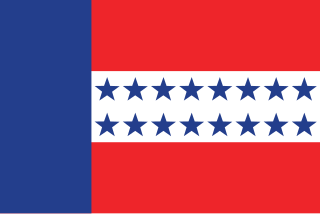
The Tuamotu Archipelago or the Tuamotu Islands are a French Polynesian chain of just under 80 islands and atolls in the southern Pacific Ocean. They constitute the largest chain of atolls in the world, extending over an area roughly the size of Western Europe. Their combined land area is 850 square kilometres. This archipelago's major islands are Anaa, Fakarava, Hao and Makemo.

Mangareva is the central and largest island of the Gambier Islands in French Polynesia. It is surrounded by smaller islands: Taravai in the southwest, Aukena and Akamaru in the southeast, and islands in the north. Mangareva has a permanent population of 1,239 (2012) and the largest village on the island, Rikitea, is the chief town of the Gambier Islands.
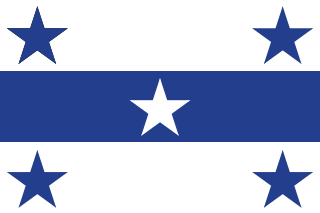
The Gambier Islands are an archipelago in French Polynesia, located at the southeast terminus of the Tuamotu archipelago. They cover an area of 27.8 km2 or 10.7 sq mi, and are made up of the Mangareva Islands, a group of high islands remnants of a caldera along with islets on the surrounding fringing reef, and the uninhabited Temoe atoll, which is located 45 km south-east of the Mangareva Islands. The Gambiers are generally considered a separate island group from Tuamotu both because their culture and language (Mangarevan) are much more closely related to those of the Marquesas Islands, and because, while the Tuamotus comprise several chains of coral atolls, the Mangareva Islands are of volcanic origin with central high islands.
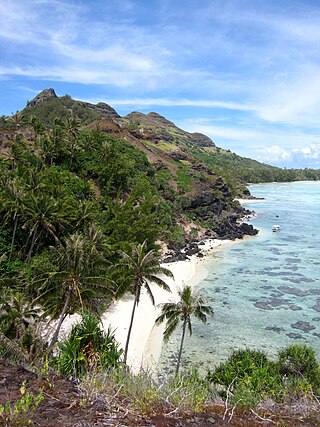
Akamaru is the third largest island in the Gambier Islands of French Polynesia. It is a small, rocky island with an area of approximately 2.6 km2 (1.0 sq mi). The island is located approximately 7 km (4.3 mi) southeast of Mangareva, which is the largest island of the whole Gambier Islands archipelago. Akamaru's highest point rises to an elevation of 247 m (810 ft).
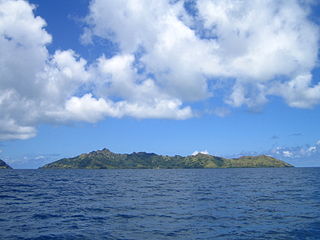
Taravai is the second largest island in the Gambier Islands archipelago of French Polynesia, at 5.7 km2. Taravai is about 1.5 km southwest of Mangareva, the largest island of the whole Gambier group, and about 300 m north of the island of Angakauitai. Off its eastern shore lies the tiny rock Îlot Motu-o-ari.
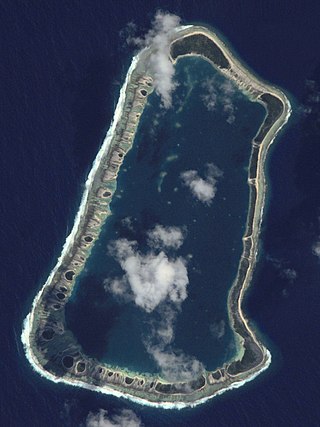
Temoe, or Te Moe, is a small atoll of the Gambier Islands in French Polynesia. It is located in the far southeast of the Tuamotu group archipelago. It lies about 37 km southeast from the Gambier Islands and more than 1,700 kilometres southeast from Mataiva, at the other end of the Tuamotu archipelago.

This page list topics related to French Polynesia.
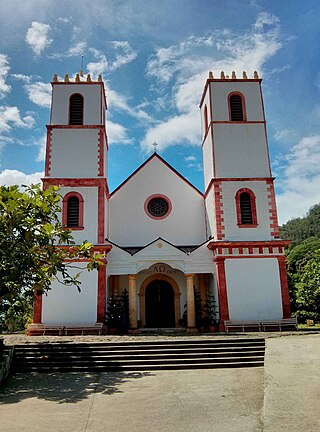
St. Michael's Cathedral, also known as the Rikitea Cathedral, is a parish of the Catholic Church located on Mangareva Island in the Gambier Islands of French Polynesia.
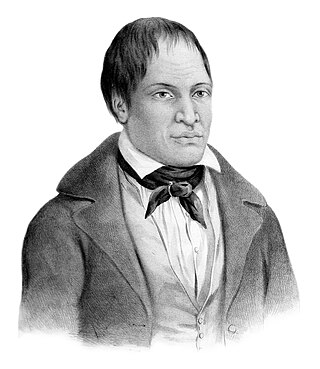
Te Maputeoa was a monarch of the Polynesian island of Mangareva and the other Gambier Islands. He was the King or ʻAkariki, as well as the penultimate king of the island of Mangareva, and other Gambier Islands including Akamaru, Aukena, Taravai and Temoe. He reigned from 1830 until his death in 1857.

Joseph Gregorio II was the last King or ʻAkariki of the island of Mangareva, and other Gambier Islands including Akamaru, Aukena, Taravai and Temoe. His short reign lasted from 1857 until his death in 1868. His childless death left the royal succession of Mangareva in doubt.
Maria Eutokia Toaputeitou was Queen consort of the island of Mangareva, and other Gambier Islands including Akamaru, Aukena, Taravai and Temoe. She served as regent for her son in his minority and for a short period afterward in the interregnum period when the royal succession of Mangareva was in doubt.

Honoré Laval, SS.CC., was a French Catholic priest of the Congregation of the Sacred Hearts of Jesus and Mary, a religious institute of the Roman Catholic Church, who evangelized the Gambier Islands.

François d'Assise Caret, SS.CC., was a French Catholic priest of the Congregation of the Sacred Hearts of Jesus and Mary, a religious institute of the Roman Catholic Church.
Cyprien Liausu, SS.CC., was a French Catholic priest of the Congregation of the Sacred Hearts of Jesus and Mary, a religious institute of the Roman Catholic Church. He headed the Roman Catholic mission in the Gambier Islands from 1835 to 1855.
Tiripone Mama Taira Putairi, SS.CC., (1846–1881) was educated by French missionaries from birth and became the first indigenous Roman Catholic priest ordained in Eastern Polynesia. He was part of the native royal family of Mangareva, and his father Bernardo Putairi was the island's last ruling regent.
Arone Teikatoara was the penultimate Prince Regent of the island of Mangareva, and other Gambier Islands including Akamaru, Aukena, Taravai and Temoe from 1869 to 1873. He served as regent and de facto monarch during the interregnum period when the royal succession of Mangareva was in doubt. His first name has also been spelled "Arona", "Aarona" or "Aarone".
Akakio Tematereikura was the Prince Regent of the Polynesian island of Mangareva and other territories of the Gambier Islands, including Akamaru, Aukena, Taravai and Temoe, in 1869. He served as regent and de facto monarch during the interregnum period when the royal succession of Mangareva was in doubt. His name is also written as Akakio Matereikura in some French sources.

Matua was the High Priest of the island of Mangareva. He served as one of the regents for his nephew Maputeoa and was instrumental in the conversion of Mangareva and the Gambier Islands to Roman Catholicism. His name is often written as Matoua.

Duff was a ship launched on the Thames in 1794. In 1796 the London Missionary Society engaged her to take a party of missionaries to the South Pacific. Once she had landed the missionaries she sailed to China and took a cargo back to England for the British East India Company. On this voyage her captain named a variety of South Pacific islands. On her second voyage to deliver missionaries a French privateer captured her in 1799 off the coast of Brazil on the outward-bound leg of her voyage.


















